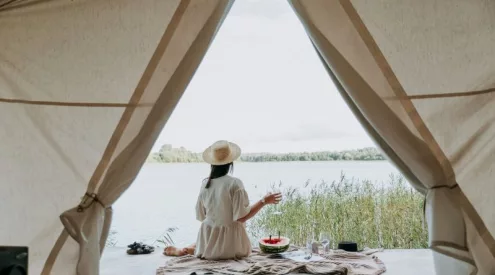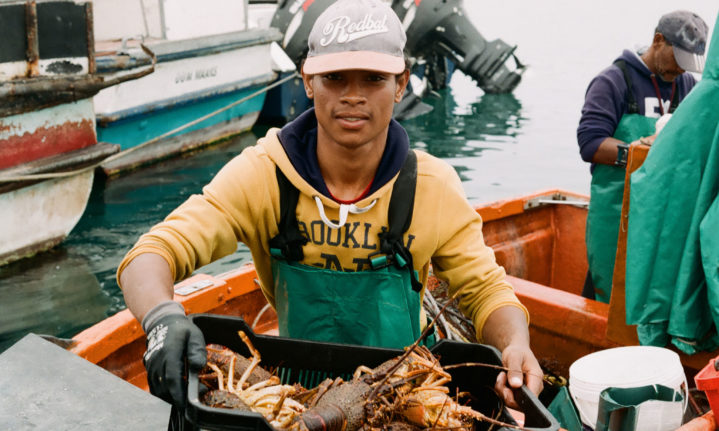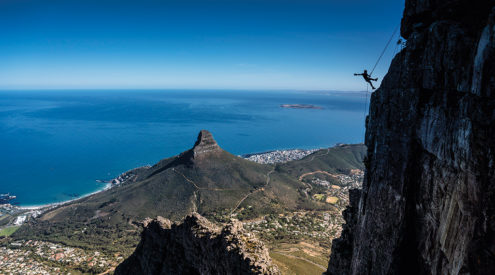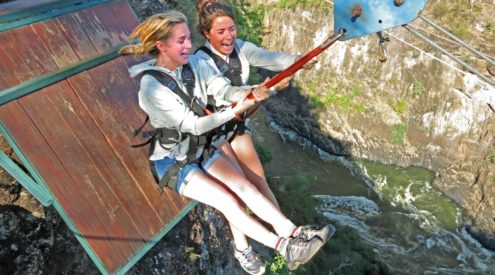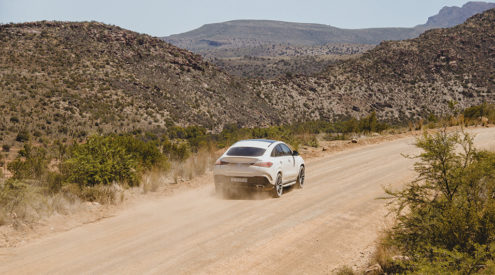Despite the bad tan, sore legs and sand in places I didn’t know I had, I arrived back from the West Coast with that somewhat elusive quality in our current world: hope.
My positive thoughts evolved over five days and 61 kilometres of walking the coast. The Crayfish Trail, I discovered, is about so much more than just walking – the hike immerses you in an area of ecological and cultural diversity.
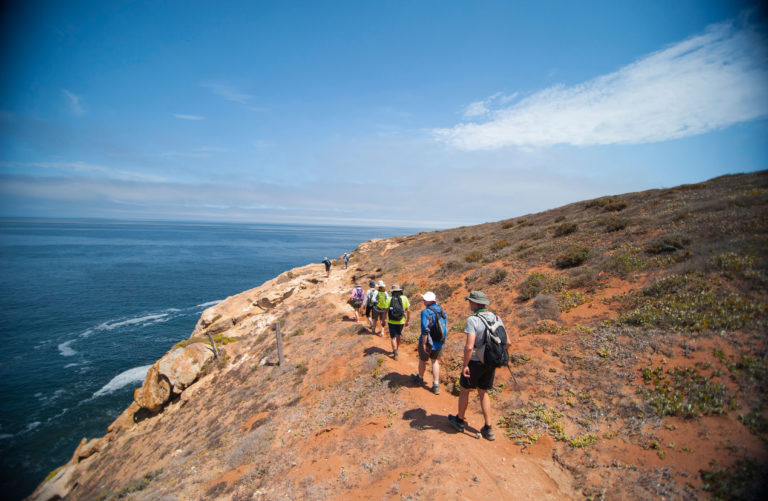
Look out for whales on the left, wild flowers to the right, on this cliff path north of Doringbaai.
It’s also home to several communities that are struggling to sustain themselves due to the dwindling fishing and agricultural industries.
The trail is the initiative of Daniel Smith (in partnership with EcoAfrica) and was born out of his thesis on community-based tourism and livelihoods along the West Coast. The plan, over time, is to move towards partial community ownership of The Crayfish Trail Co.
Rocherpan is a CapeNature reserve where the buildings of the eco-lodge blend into the dusky landscape. Arriving in the late afternoon, we made the short walk to the bird hide overlooking the pan itself, and afterwards to the beach.
We rose early to meet the sun coming over the horizon – no trees, just a vista of sharp, glinting fynbos. As we shuffled off the sleep, community guides Damien Blignaut and Patrick Adonis told us about the animal spoors patterning the sand as we set off along the beach. The first life we saw was a pair of wild ostriches, two complementary dots running into the distance.
Also read: Rocherpan Nature Reserve: the perfect escape for nature lovers
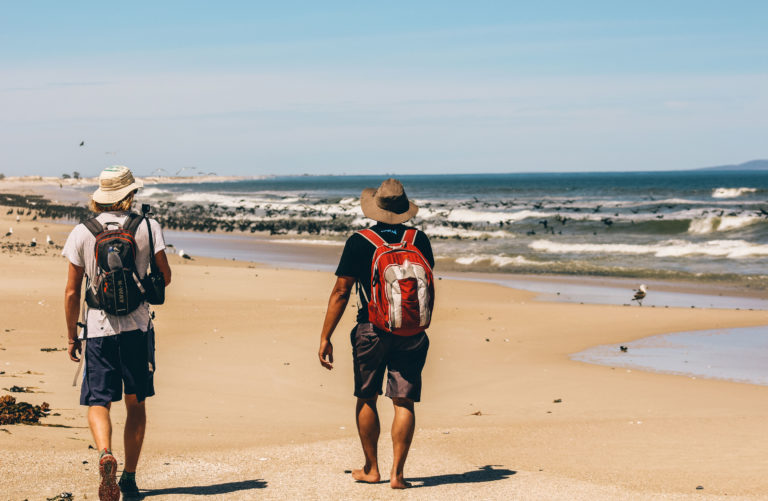
Cormorants descend on the beaches in great numbers
It was wonderful, walking and thinking, through that landscape of sand and shrubs in the screaming sun of midday, with kelp rising like strands of hair in the water to glisten on the surface. My feet moved in rhythm with my thoughts, as I considered them one by one and then stripped them down. It’s like clearing wallpaper from the mind. Chester van der Heever, a later guide, would tell me, ‘Die see sal altyd jou gemoedstoestand verander.’ (The sea will always change your mood.) Yet it’s not without cruelty, and we passed countless carcasses of seals on the beach.
Lunch was a delicious meal at the restaurant at Draaihoek, then we drove the last stretch to Vensterklip guest farm outside Elands Bay and indulged in a much-needed nap. That evening we watched the sun set from a cave above Baboon Point. The cave is filled with San art dating back countless centuries and overlooks a world-famous surf break. Dinner was back at the farm in a cosy setting, with only four tables in a low-ceilinged room with rough stone walls. Between us flowed red wine and talk of the day, before the satiated yawns began.
The next day was our longest, and we were grateful to swap sand for some jeep track, but not before we saw the many namesake crayfish doppe (shells) littering the beach, and watched Heaviside’s dolphins surfing the waves. Then our route swung up alongside the railway tracks, where three-kilometre-long trains carry iron ore from Sishen to Saldanha several times a day. A vlei full of flamingos lent the water a pinky sheen.
Steenbokfontein farm is a hidden shard of the past. Kitta Burger, our hostess, ushered us into the dining room with its huge hearth, wood-burning stove and old family photos lining the walls. The farm has been home to six generations of Burgers, dating back to 1833; the house in which we sat was built in 1864. She told us about the wreck of HMS Sybille, which struck a reef near the farm at 2am on 12 January 1901.

It’s not called the Crayfish Trail for nothing – this catch was in Lambert’s Bay
Kitta’s hospitality is old-school: keen and warm. For lunch we were fed mussel soup with thick slices of farm bread, fishcakes, snoek, crispy potatoes, baked asparagus, slaw and stewed apricots. After much-needed time to digest the meal, manifesting in a nap, we took a tractor ride round the farm. I let my feet dangle over the side, swinging my legs like a kid as I watched the fields go by. We visited two more caves, also bearing marks of the San. Dinner was another extravagant affair: lamb potjie, green beans, aniseed sweet potato and koeksisters to finish.
Our new guide for the fourth day was Chester, who accompanied us along the beach to his home ground, Lambert’s Bay. Mist hung over a mercurial sea, so dense we could only just make out oystercatchers on the rocks. For three hours we crunched over mussel graveyards and kelp-strewn sand, while Chester told me of the community’s issues with drugs and the loss of livelihood for local fishermen.
Both his grandfathers were fishermen, as is his father, but with the enormous commercial fishing quotas and the rapidly declining fish population, the catches are no longer enough to feed a family. It seems bizarre that the descendants of the San, who lived off the land in a way that let itreplenish itself, should now be denied access to the fruits that once sustained them.
At Lambert’s Bay we headed for Bird Island, adjacent to the fishing harbour. Another CapeNature reserve, it is one of only six sites in the world where Cape gannets breed – and the only one where they can be viewed up close. We smelt them before we saw them. From behind glass in the hide, we observed the chaos that is the inner workings of a large group of wild animals. It was a bit like David Attenborough live, but with Chester’s (he used to work here) unique commentary.
That afternoon, in our beachside accommodation at Arendzicht, we were treated to a chocolate-and-wine pairing and met some fishermen piloting a new mobile app called Abalobi (meaning ‘small-scale fisher’ in Xhosa – see box, right).
For dinner I enjoyed my first vegetarian meal of the trip, cooked by Paula van Rooyen. She was the head chef at a local restaurant but had to leave when her second child was born. Her food certainly showed a decade’s worth of experience, and Daniel is hoping to start a homestay with her for future trips.
Our last day started with a drive to the small town of Doringbaai, from where we walked along the cliffs with the fog-laden Atlantic Ocean stretching out to our left; red rock and fynbos to the right. Our meander took us to the holiday hamlet of Strandfontein, after which we returned to Doringbaai to visit the old crayfish factory, part of which has become Fryer’s Cove winery, producers of the well-known Doringbay wines. The remainder of the factory has been converted into an abalone farm, which employs many locals and is part-owned by a community trust. We stole a look inside, marvelling at the outrageous value of these strange shellfish.
In the Doringbaai Seespens restaurant that evening, I enquired, just for the hell of it, about any vegetarian options. The friendly waitress gazed at me puzzled and said, ‘Well, we have chicken and fish.’ So I ate my first-ever ‘Hottentot’ fish, not knowing whether to baulk or laugh at the name. At least it was local and sustainably caught.
Sustainability, local entrepreneurship and communities working together is, I reflected later from my patio at Thornbay Lodge, exactly what the Crayfish Trail is all about. And projects like this give me hope for our country’s future. The sun had drawn up all the mist from the water and as it sank, there appeared a glimmering wake on the surface, creating a path of light across the bay.

A fishing skiff’s name wishes hikers well on their journey: Mooiloop (go well)
Crayfish Trail
Duration 2–6 days; Type Guided; Level Moderate
Plan your trip
Getting there
From Cape Town, it’s about two hours’ drive on the R27 through Velddrif to the Rocherpan Nature Reserve gate.
Need to know The trail can be walked year round, but midsummer can be hot and windy. Group size is between four and 12 people. The terrain is mostly flat, over beaches and jeep tracks, and a backup vehicle is on standby. At the end, guests are taken back to their vehicles at Rocherpan. Transport can also be arranged from Cape Town.
Rate & Booking The three-day trail costs from R3,200 per person; the six-day option is from R8,000 per person. All meals, transport of luggage (and people if needed), local guides and activities are included (alcoholic drinks are for your account). 0835539107, crayfishtrail.co.za
Abalobi – from hook to cook
This app connects small-scale fishers directly to the marketplace, records data and helps fishers manage their finances. Their daily catch is uploaded onto the app and restaurants can then place an order. Diners, too, can use the app to see when and where the fish was caught.
Text and images: By Catherine Rudolph








